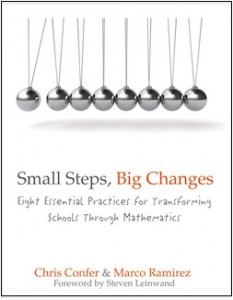Essential Ideas for Math Success
Small Steps, Big Changes: Eight Essential Practices for Transforming Schools Through Mathematics
By Chris Confer & Marco Ramirez
(Stenhouse Publishers, 2012 – Learn more)

Chris Confer and Marco Ramirez are searching for an answer to the question, “What does it take for the majority of the students in any school to be successful in mathematics?” That is a question many educators are finding themselves asking in 2012, especially with the increasing stress of high stakes testing. Confer and Ramirez take their question one important step further by asking: “What would it take to sustain that success?”
Small Steps, Big Changes seeks to help others benefit from the answers Confer and Ramirez have discovered as they’ve worked with their own school and others across the United States. It outlines eight essential ideas that they believe can guide schools to continuing success in mathematics learning and achievement.
Each essential idea has its own chapter, where the authors explain how that idea can be utilized to create positive change. At the end of each explanation, the authors provide three stories reflecting upon that essential idea. In each instance, the stories are told from the viewpoints of a principal, a coach, and a teacher.
Each school is unique

Each school needs to find its own questions to fit its particular needs. It’s important that schools not just try to implement a specific example from the book, end up failing, and give up. Teachers and school leaders need to work together to define their unique circumstances and customize the ideas they find in Small Steps to fit their needs.
Essential ideas that resonated
One essential idea that I found helpful is the 80/20 rule. This rule says that educators need to put 80% of their attention on what matters most and spend no more than 20% of their time on things that are necessary but may not have long-term effects on the school. All of us who are teachers know how hard is to manage time because of all the different responsibilities placed upon us. This rule of thumb reminded me that I need to focus on the most important teaching tasks — the ones that will have bigger effects on my students — instead of spending so much time on tasks that do not benefit the school or students.
Another essential idea that resonated with me was intentionality. This chapter focused on how to create a culture of “can” in the classroom and specifically states, “A culture of ‘can’ is not created by teachers and principals alone; it comes about when students themselves discover that they can be successful.” (2012, p.134).
Teachers and principals can help students to feel successful by keeping high standards in the classroom and creating high-quality lessons. This is something that, as a teacher, I was happy to be reminded of, and it really got me questioning whether my lessons were helping to create a “can” culture.
Key elements of transformation
A key story in the book describes a multi-year effort led by Ramirez (principal) and Confer (instructional coach) to improve math instruction at a Tucson, AZ elementary school. The publisher’s description of the book summarizes what happened this way:
A few years into the change process, Pueblo Gardens — a school with 96 percent of its students at the poverty level and a high percentage of English language learners — had 94 percent of students meeting or exceeding state standards in third-grade mathematics. Over time, other grades achieved similarly high scores. And once the test scores rose, they were sustained at high levels.
While I thought this book was very well written and had great examples of how to increase mathematical learning in a school, it was clear that a committed principal and a math coach were essential elements in achieving whole-school transformation at Pueblo Gardens. At my school there is no math coach, so I was unsure if this model would work well. The regular support of a math coach had a big part in helping teachers with the changes. I was also not sure how schools would be able to undertake this change if the principal was not on board.
It is always nice to hear a success story in education and this was clearly one example of that. I felt as though the eight essential practices were clearly defined and supported throughout this text. For a school searching for more success in mathematics, this is a definite read!
Michelle Schwartze is a middle school mathematics teacher. She has been teaching in the middle grades for the past 11 years in Peoria, Illinois. Michelle is currently taking classes towards a doctorate in Curriculum and Instruction with the hope of working in higher education.




































Hi Michelle,
Thank you for your thoughtful comments regarding the book Small Steps, Big Changes: Eight Essential Practices for Transforming Schools Through Mathematics. It is always helpful to us to hear what parts of the book resonate with different people. Your ideas regarding intentionality and the 80/20 rule were very helpful. And it’s so true–each school has to carve out its own unique path.
With that in mind, it’s true that many schools have no math coach, and a principal like Marco is unusual. We work in many schools and districts where all the support pieces are not in place–in fact that’s what we usually encounter. So we have to work around the missing pieces and build upon the strengths that are present. The necessary ingredient is a core of people who take on that leadership role. Maybe that’s our next book!
Thank you for all that you do to support math education in our country, Michelle. We appreciate you. Keep in touch!